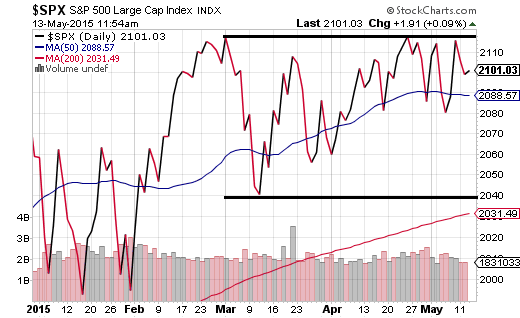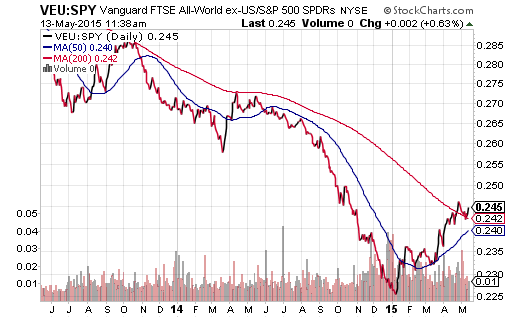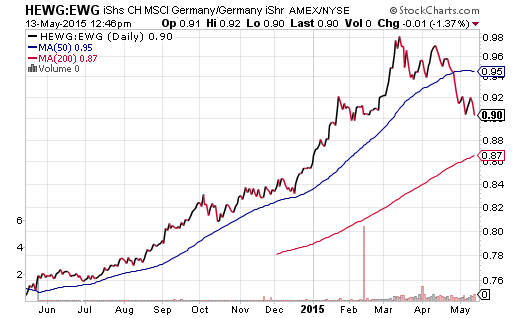As much as investors might like to believe that the U.S. stock market is still “grinding higher” in 2015, the reality is that it may be grinding to a halt. S&P 500 stocks have been stuck in a 4% trading ranged for the last 10 weeks; they’ve been stuck in a 2% trading range for approximately one month.

The reasons for the range-bound entanglement? One might point to rising bond yields. Others might see an economy that is inching perilously close to contraction – an economy that would only be hampered further by rising borrowing costs. Still others fear super-sized strength in the U.S. dollar and its adverse impact on the profits of U.S. corporations.
Each of these concerns certainly has something to do with the narrow trading range for U.S. stocks. Yet the argument can be made that none of these issues is as powerful as the expressed desires of the Federal Reserve. They want to be seen as accommodating as they maintain historically low overnight lending rates and they want to be seen as proactive in hiking borrowing costs ever so slightly at some point in 2015. Unfortunately, the high-wire act may be more difficult than members of the Fed bargain for. First of all, the U.S. economy has shown few signs of being able to handle the removal of any borrowing cost stimulus. Secondly, the mere expression of an intent to “normalize” rate policy has already created mini temper-tantrums in bonds and currencies.
Ironically enough, the big story in 2015 may not even be the Fed’s hope for tightening monetary policy in the summer or fall. On the contrary. Judging by the relative strength of international stock ETFs in 2015 – a four-and-a-half month period where central banks across the rest of the world have slashed rates/engaged in policy easing nearly 50 times already – investors have been chasing the stimulus train.

The easiest way to visualize the stimulus chasing? Take note of the year-to-date affection for international stock ETFs in the Vanguard FTSE All World ETF (NYSE:VEU):S&P 500 SPDR Trust (ARCA:SPY) price ratio. For the first time in a number of years, VEU has steadily gained momentum on SPY. The VEU:SPY ratio is above a long-term 200-day moving average; VEU:SPY also appears to be setting up for a “golden cross” – circumstances where the short-term 50-day moving average climbs above a 200-day.
For years, I have advocated strongly on behalf of the dollar-hedged international ETFs. I was one of the earliest proponents of the WisdomTree Currency Hedged Europe ETF (NYSE:HEDJ); many of my clients own iShares Currency Hedged MSCI EAFE (NYSE:HEFA) and/or iShares Currency Hedged Germany (NYSE:HEWG). The idea has always been to remove currencies from the investing equation when investing internationally, particularly when exposure to the foreign companies might have been enough risk for ethnocentric Americans.
Yet the reality of the “will-they-or-won’t-they” speculation on a Fed policy shift has created an environment where sticking with the greenback is far from a sure thing. An unwinding of the euro carry trade has been making traditional international stock ETFs more successful than their currency-hedged equivalents since early March. Look at the price ratios for HEFA:iShares MSCI EAFE (ARCA:EFA) and HEWG:iShares MSCI Germany (ARCA:EWG) in the charts below.


You do not have to shift back and forth between a currency-hedged international vehicle; rather, the key is simply recognizing that international stock ETFs have the stimulus to outperform an all-domestic portfolio. In other words, get your exposure one way or another. Or, better yet, pick up an unhedged basket of diversified international holdings via VEU as well as a currency hedged international asset like HEFA. It’d be a mistake to count on the S&P 500 to carry the entire weight of your portfolio’s stock universe.
Disclosure: Gary Gordon, MS, CFP is the president of Pacific Park Financial, Inc., a Registered Investment Adviser with the SEC. Gary Gordon, Pacific Park Financial, Inc, and/or its clients may hold positions in the ETFs, mutual funds, and/or any investment asset mentioned above. The commentary does not constitute individualized investment advice. The opinions offered herein are not personalized recommendations to buy, sell or hold securities. At times, issuers of exchange-traded products compensate Pacific Park Financial, Inc. or its subsidiaries for advertising at the ETF Expert web site. ETF Expert content is created independently of any advertising relationships.
Which stock should you buy in your very next trade?
With valuations skyrocketing in 2024, many investors are uneasy putting more money into stocks. Unsure where to invest next? Get access to our proven portfolios and discover high-potential opportunities.
In 2024 alone, ProPicks AI identified 2 stocks that surged over 150%, 4 additional stocks that leaped over 30%, and 3 more that climbed over 25%. That's an impressive track record.
With portfolios tailored for Dow stocks, S&P stocks, Tech stocks, and Mid Cap stocks, you can explore various wealth-building strategies.
